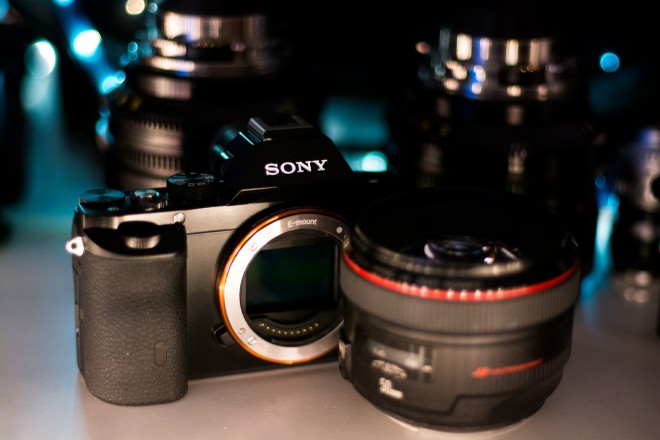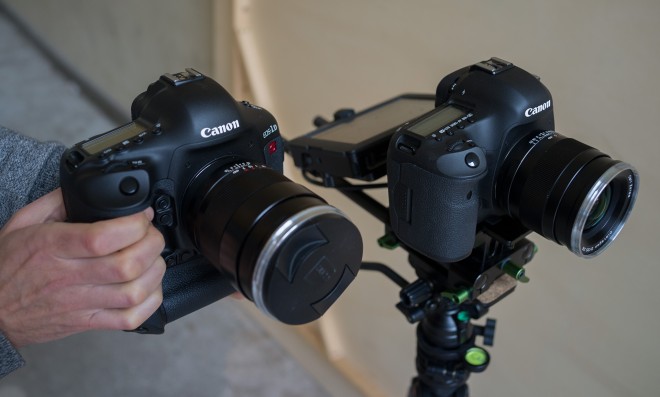
This began as a 10 point list. It grew…
I am huge fan of the 1D C’s image but not the camera itself and especially not the price. The 1D C when it was introduced offered an absolutely lovely image and still does but now the playing field is rapidly changing.
Exactly how does the Sony A7S compare on paper to the 1D C?
Low light – the 1D C made a good claim as a low light champion but the A7S takes this to new extremes. It’s no gimmick. You can now get more manageable focus pulling in low light at F5.6 and boost ISO. Creatively and in terms of the look, light behaves differently on screen at high sensitivities and more types of light sources can be used in a practical way even moon light. Personally I am crazy about it.
Full frame – the 1D C is not actually full frame in 4K mode, it is a 1.3x crop
Dynamic range – in terms of the raw sensor output the 1D C rates for just under 12 stops but the A7S pushes on for 14. Not all of these stops are usable for video but the 4K HDMI output of the A7S is looking very impressive in this respect
Codec – the 1D C does do 4K internally but the cost of that is you’re stuck to MJPEG at 500Mbit. Card space gets gobbled up very quickly as it is not an efficient codec. With a 4K HDMI output you have a choice of codec including ProRes, and in future, H.265
Better internal 1080p – full frame 1080p from the 1D C is almost as soft as it is on the 5D Mark III. Full frame 1080/60p on the 1D C is even worse. The A7S does a full pixel readout so internal 1080p is finely detailed straight off the bat at both 60p and 24p
Price – the A7S is $2498 at B&H. That is $10,000 less than the 1D C list price and $8000 less than the currently discounted 1D C at B&H
Mirrorless lens mount – everything fits (including Canon EF). Leica M lenses are the cream of the crop and to shoot 4K with these is a dream
EVF – you cannot shoot video through the optical viewfinder on the 1D C. The EVF on the A7S is as large as the current class leading Fuji X-T1’s EVF at 0.5″, though the optics aren’t quite as nice
Better focus assists – As well as focus peaking which the 1D C does not have it, the A7S allows you to punch in for critical focus WHILE recording
4K monitoring – HDMI on the A7S of course will monitor at 4K which is great for critical focus without any other assists. Monitoring on the 1D C tops out at 1080p
Articulated screen – if shooting minimal without an external monitor, this is really handy on a tripod and saves your back
Smaller size – though still small by cinema camera standards, being based on the 1D X, the 1D C is as chunky as stills cameras get. The A7S is as small and light as full frame interchangeable lens cameras get, so polar opposites. Too small? Not really…
Drone work – the physical aspects of the A7S will come in handy for aerial work (as do the equally small lenses you can fit to the mirrorless mount)
Silent shutter mode – I find this feature invaluable for stealth situations, for example shooting behind the scenes, photographing the performance of a musician, street shooting and so on
S-LOG 2 – this uses the true native ISO (3200) of the A7S for maximum dynamic range whilst Canon LOG on the 1D C does not use the native ISO of the sensor. Though you need strong ND filtration this mode does seem to get dynamic range close to 14 stops so very film like. It gives you the flexibility in your grade too for heavy changes plus the ability to match the curve you grade from to the curve from other S-LOG cameras. The 1D C has LOG but no ability to tune it…
[vimeo]http://vimeo.com/99739214[/vimeo]Above: 4K and S-LOG test by Philip Bloom with original 4K file available to download for Vimeo Plus members
Video orientated picture profile settings – like the Sony FS700 the A7S has controls for Black Level, Gamma (Movie, Still, Cine 1-4, ITU709, ITU709 [800%], S-Log2), Black Gamma, Knee, Color Mode, Color Level, Color Phase, Color Depth and Detail. Picture profiles can be saved, copied and shared. The 1D C features no such capability at all.
AF for stills in low light – this camera can auto-focus in the dark. The 1D C relies on phase detection which requires far more light
30p – The 1D C does not record 4K at 30p. The A7S has 30/25/24p and PAL versions of the camera are expected to be PAL / NTSC switchable world-cameras. The US version sadly is locked to NTSC.
Zebra – Something else very basic that the 1D C relies on an external monitor for, is included in-camera on the A7S
Better live view – It goes without saying that the 1D C is based around an optical viewfinder for stills. Stills on the A7S benefit from the advantages of live view including much faster contrast detect AF in live view than even the Canon 70D with it’s dual-AF technology. The 1D C’s live-view is not up to modern standards.
Internal APS-C crop mode – Though the 1D C does have a very good Super 35mm crop mode via HDMI, the A7S has one internally as well
PL mount compatibility – All cinema lenses in PL mount (Cooke S4, Zeiss CP, etc.) fit the A7S but not the EF mount on the 1D C, whilst the APS-C crop mode mimics the sensor size of Super 35mm making these lenses fully usable
WiFi remote control – this is useful for hands-free control of the A7S when it is in a difficult to reach position, also wireless monitoring. The 1D C does not feature built in WiFi.
Less potential for depreciation in the thousands of dollars – for Canon’s first 4K DSLR at $12,000 that is some hefty potential for depreciation, though most 1D C owners I am sure have justified this through using the camera professionally, it’s still a lot of money for what is essentially a tweaked $6000 1D X
SSD media for 4K recording – 4K on the A7S via the Atomos Shogun will use SSD media whilst the 1D C uses 1000x Compact Flash cards for 4K recording. Capacities are limited and pricing per GB is much higher
Does not need sending to service centre for firmware updates – the A7S is normal in this respect. Canon require you to send the 1D C away for firmware updates because they want to keep the firmware file out of the public domain. The danger of third party developers improving the camera is just too much 🙂

EOSHD opinion
The mounting excitement for the A7S is palpable. And we’re not talking merely of hype but the actual creative possibilities of using one. I love what Sony have done for the price in a prosumer camera.
Clearly at this moment in time Canon have some catching up to do when it comes to 4K. I am sure they are planning this right now but Canon’s low end is a mess even for 1080p. None of their sub $9999 cameras do 4K and aside from Magic Lantern raw, their pro DSLRs don’t even do 1080p very well. Affordable 4K solutions are now offered by Sony, Panasonic and Blackmagic. 4K makes for wonderful 1080p. Even RED too come under $10k if you count the Scarlet brain only or second hand RED ONE bodies.
For pros wanting the absolute best shooting experience on a full frame 4K sensor the 1D C is not that camera. For a start it is a 1.3x crop in 4K and the stills orientated ergonomics of the 1D C along with so many missing video features make it a pain to use while the A7S is much better. Canon do not have a proper 4K codec yet either. The Super 35mm C500 requires an external recording solution to provide the codec support for 4K. The 1D C essentially uses a JPEG codec which is a stills standard not a video one.
It is clear that Canon did the barest minimum to change the 1D X and turn it into a 4K recording DSLR for a very small niche of Hollywood filmmakers, mainly from their feedback, without addressing the needs of the wider video market.
I am concerned that by the time Canon addresses the needs of the wider market for 4K, users might have begun to migrate away from Canon – I speak by personal experience here – though in the case of the A7S I am certainly bringing the Canon lenses along for the ride.
I said this last year and the year before… The time is now (overdue) for Canon to start being interesting again and responding to the competition.


